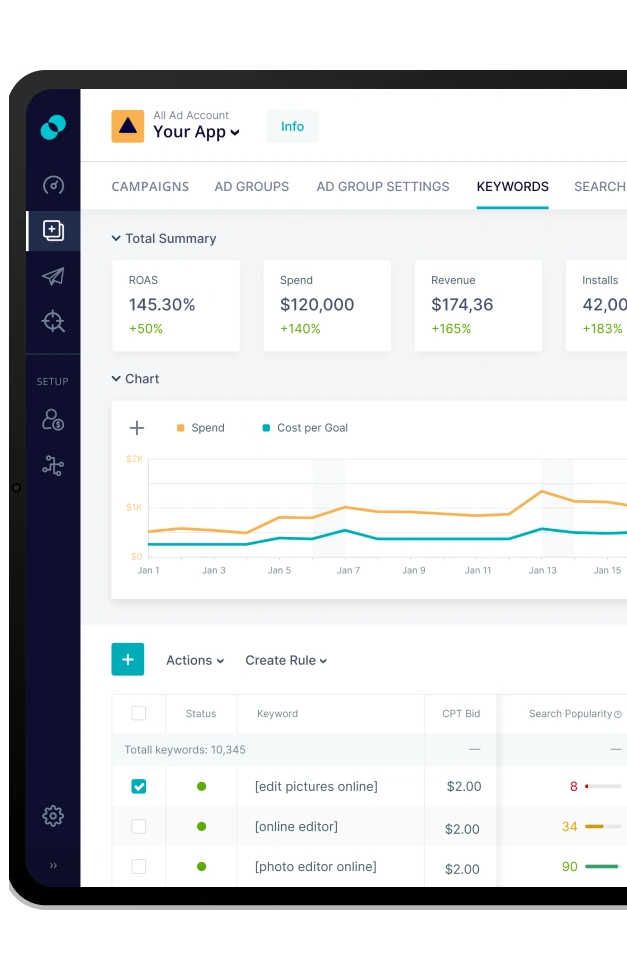5 Apple Ads Myths Debunked
 Anastasiya Starovoytova
Anastasiya Starovoytova Getting an app to the top of the App Store seems like climbing Mount Everest. Or does it?
TechCrunch has recently cited a new study by Sensor Tower. According to the research, it takes more downloads to rank first on the App Store than before. To become number one in the United States, an app now needs about 156,000 daily downloads. These figures mark a 37% increase compared to 2019. At the same time, Android apps only need 56,000 downloads a day to come out on top, a 33% drop from 83,000 in 2019.
Don’t let the findings dishearten you. While competition does get more ruthless, you can still emerge victorious by working on your product page and running Apple Ads.
Some publishers hesitate to put time and effort into this acquisition channel or don’t unleash its full potential because of misconceptions and so-called ‘‘facts’’. In this article, we’re going to dig deeper into the fog and debunk Apple Ads myths once and for all.
The most cited complaint about Apple Ads is that the channel is unreasonably expensive to work with.
Let’s get to the bottom of this conviction.
Apple Ads is a premium channel attracting users with a high intention to install an app. According to Apple, 70% of the App Store visitors use search to find an app, and 65% of downloads take place after the search. The average conversion rate is more than 50% for search results ads. Besides, the App Store traditionally outperforms Google Play in revenue. In the first quarter of 2022, the App Store generated income which was more than twice of the one by Google Play, says Sensor Tower.
Another thing to consider is that amount you spend on Apple Ads depends on different regions and verticals. For instance, the competition in the US fintech segment is much more intense than the one for lifestyle apps. Seasonality also plays its part here: if you’re running a dating app, for example, you can see that traffic gets more expensive prior to Valentine’s Day or during Pride Month.
When it comes to Apple Ads spendings, we recommend keeping an eye on Apple Ads Benchmark Reports. By using the data, you’re able to understand the market better and watch over conversion metrics costs. Enlisting a third-party tool like SplitMetrics Acquire can also be helpful as it enables you to use aggregated AI recommendations to control your biddings and budget.
So, can Apple Ads be expensive? Sure. But the channel is totally worth it. Besides, you don’t need a huge budget for the channel to start working. Thomas Petit put it down the best in his article for RevenueCat:
“For limited ad budgets in the early phases of growth, Apple is a great place to start advertising until enough money can be invested into more sophisticated channels. As a bonus, if you’ve never advertised on Apple Ads before, Apple will give you your first $100 in ad spend”.
Don’t let the words “Apple Ads is way too expensive” stop you from discovering this channel. And remember: proper research, tools, and dedication can really work wonders.
Leverage the real-time Apple Ads Benchmark Dashboard to access up-to-date insights on TTR, CVR, CPM, CPT, CPA for Apple Ads.

Apple Ads run on a second-price auction model meaning you’re paying what your nearest competitor is ready to pay. Advertisers make a bid for keywords they want for their ad placement, and the best offer wins.
For beginners, the system can be a bit confusing. After all, if this is an auction, how can you stand against brands with deep pockets?
There’s no denial that having a significant Apple Ads budget will ease the way to the top, but one can’t just place a ridiculously high bid and get away with it.
Apple values great customer experience above all else. It doesn’t matter how much advertisers are willing to pay if they aim at keywords irrelevant to their app and their app’s TTR is historically low. They won’t be able to enter the auction in the first place.
One of the most persistent Apple Ads tales is that bidding on branded keywords triggers traffic cannibalization. In this context, paying for branded keywords looks like a total budget waste.
Let’s make this belief pass a reality check.
First, over 50% of searches on Apple Ads are branded. This means that the App Store boasts of highly motivated users that know what they want.
Second, branded keywords are also the most converting ones, and they will get into the search match auction anyway. If you don’t bid on them, someone else will. And that someone will eventually rank higher than you. Having a well-known brand won’t help if you neglect bidding on your branded keywords.
Third, there are two scenarios regarding cannibalization to play out when talking about paying for traffic.
The first case is smooth sailing. Bidding on branded keywords positively affects the organic ranking and conversion rate of your app. It’s a win-win situation: you climb the App Store Ladder without eating your own traffic. What’s more, you can spot app growth opportunities while staying within the target budget.
In the second scenario, cannibalization strikes if you occupy one of the first three spots in the App Store search organically and the keywords you’re bidding are top ones in organic traffic. In case you’re on the second or third place in the organic traffic results, users won’t see your app on their smartphone screens until you turn the tables and rank first.
When it comes to mobile growth, cannibalization is a real trickster. In order not to fall victim to it and the myths accompanying it, your best move is to keep tabs on organic rankings for your desirable keywords and watch your competitors and their biddings closely. This will help you react immediately to their attempts to snatch your branded traffic.
One of the biggest misconceptions about Apple Ads is that you can’t scale with this channel.
You can meet both mobile marketing experts and newcomers among the disciples of this myth. Some believe Apple Ads are good for brand defence only because their scaling attempts weren’t successful. Others are sure the platform can deliver modest results, and that’s it.
Sounds discouraging? Don’t jump to conclusions.
Apple Ads may differ from other acquisition channels, but that doesn’t mean it can’t boost mobile growth. There are plenty of success stories to take a page out from.
Thomas Petit, a world-renowned mobile marketing expert, once shared with SplitMetrics the story of Pictarine able to scale one keyword in one geographical region to 6 digits monthly. Andrea Raggi, Team Lead Performance Marketing at Phiture, solved the scale problem by carrying out extensive keyword research in different languages.
The CEO and co-founder of App Radar Thomas Kriebernegg also mentioned that his company collaborated with more than a hundred of apps for Apple Ads campaigns, and most of them were a success.
Roman Pylypchuk, User Acquisition Manager at United Tech and a client of SplitMetrics Acquire, achieved outstanding results with Apple Ads by getting x3 installs in 2021. In Roman’s opinion, the key mistake most marketers make when attempting to scale is forgetting to integrate a 3rd party optimization platform. This causes a significant lack of post-install performance data.
The stories above prove that scaling with Apple Ads is a reality, even if folk wisdom tells you otherwise.
It’s crucial to understand that scaling strategies should be custom-developed for your app and its objectives. However, there are several recommendations everyone can use. Here’s a list of the best practices we collected together with Thomas Kriebernegg from App Radar:
By adopting the constant learning approach to your efforts, you will be able to get amazing results with Apple Ads and see that the “scaling is impossible” statement is a mere myth.
This myth speculates that Apple Ads and optimization can’t go hand in hand.
Since there is a data gap between Apple Ads and an MMP, you have to collect information from both sources and put it into a separate document. Basically, you spend more time on Excel tables than on the channel.
Another issue that comes to mind is that UA managers have to control bids and keywords manually. This is a time-consuming process that take a toll on your team’s productivity and results: as we found out before, the lack of post-install data can seriously affect your scaling strategy.
It’s possible to overcome the platform limitations by using a third-party solution, such as SplitMetrics Acquire.
By enlisting such a solution, you’ll be able to:
In a nutshell, the myth is based on real issues UA managers face, but the problems above can be easily solved.

Our journey has come to an end. We’ve debunked five common myths surrounding Apple Ads and found out that all the obstacles can be surmounted.
Of course, there are other misconceptions to hunt down and puzzles to solve. If you’d love to learn more about mobile growth myths, make sure to check out our App Growth Panel with Niels Beenen from Singular and David Barnard from RevenueCat.
Have another Apple Ads question on your mind? Our professional mythbusters at SplitMetrics are always ready to help you out.
